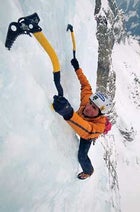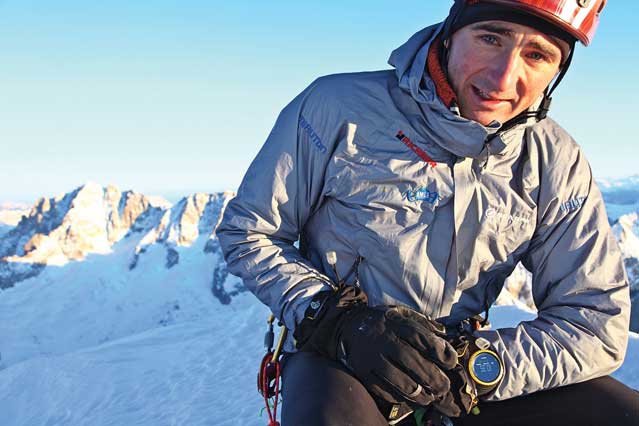UELI STECK, known in mountaineering circles as the Swiss Machine thanks to a short film of the same name documenting his feats, promised his wife that he was done soloing. But when the 34-year-old Ringgenberg climber unzipped his tent on the evening of April 16 and stepped into the bright moon glow beneath the southwest face of Tibet’s 26,289-foot Shishapangma, he couldn’t contain himself. “I was just thinking, I am going out to check the conditions up to 7,200 meters,” the Mountain Hardwear–sponsored athlete reported sheepishly after completing a record-setting 10.5-hour summit sprint, minus his partner, Canadian Don Bowie. “But things went well.”
Ueli Steck solo ice-climbing in Switzerland in 2005.
 Ueli Steck solo ice-climbing in Switzerland in 2005.
Ueli Steck solo ice-climbing in Switzerland in 2005.Ueli Steck descending the southwest ridge of Nepal's Cholatse earlier this year.
 Ueli Steck descending the southwest ridge of Nepal’s Cholatse earlier this year.
Ueli Steck descending the southwest ridge of Nepal’s Cholatse earlier this year.That ascent kicked off Project Himalaya, Steck’s 2011 bid to summit three 8,000-meter peaks in a single season. By early May, he had also climbed 26,906-foot Cho Oyu and moved on to 29,035-foot Everest. But on May 21, in bitterly cold weather, he turned back within 100 meters of the summit. Hey, it’s still Everest.
Though he didn’t complete his supermission, you should expect incredible feats from Steck in the years ahead. Among climbers, he’s best known for a million-hit viral YouTube video in which he solos the 5,940-foot sheer north face of Switzerland’s Eiger, unroped, in 2 hours and 47 minutes, shaving more than an hour off the previous record, which he also held. Accomplished teams often take days to climb the route.
For being able to ascend as fast as he does on such difficult terrain and at such punishing altitude, Steck credits an intense fitness regimen. Last year he logged more than 1,200 hours of endurance training under the tutelage of Simon Trachsel, a physiotherapist at the Swiss Olympic Medical Center. “He’s playing the game more seriously than the rest of the world,” says Simon Anthamatten, a regular training partner.
But the risks associated with his mountaineering style weigh heavily—and with good reason. Steck’s exploits are so dangerous that death seems likely if he keeps up his current pace. Slovenian alpinist Tomaz Humar made headlines after speed-soloing the world’s seventh-highest mountain and then died alone on a Nepalese peak in 2009.
“Humar, he had [26,795 foot] Dhaulagiri,” says Steck. “And after, he tried to keep up with that.” Ultimately, Steck’s biggest achievement might not be his summits but his willingness to walk away from them. While in the Himalayas, he received news that his Eiger record had fallen to 27-year-old Swiss alpinist Dani Arnold, and Steck has no plans to try and reclaim it. Returning home, he took a much-needed vacation with his wife instead.
“I’ve been working for two years to get away from solo climbing,” he says. “If you do it too long, if you do it too much, you’re going to die for sure.”


